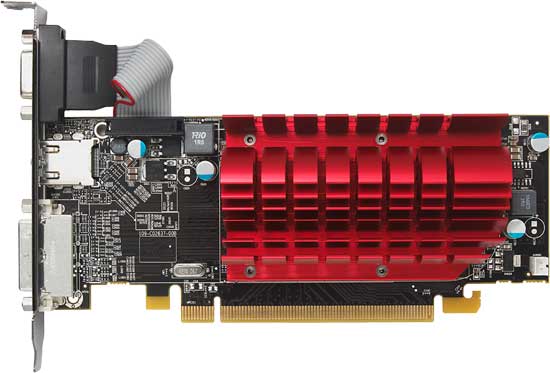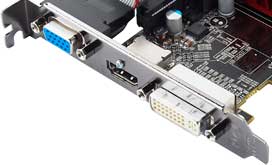AMD’s Radeon HD 5450: The Next Step In HTPC Video Cards
by Ryan Smith on February 4, 2010 12:00 AM EST- Posted in
- GPUs
Meet the 5450
As luck would have it, we ran in to a bit of a snafu yesterday morning when wrapping up our test of the 5450. As we stated in our intro, the DDR3 Radeon 5450 is supposed to be clocked at 650MHz core and 800MHz memory, but that’s not what we got. Internally AMD has been sampling a 650MHz/900MHz card for one of the OEMs they work with, and a few of those samples made it out with the 650MHz/800MHz review samples for the press. As one of the (un)lucky winners, we received a 650MHz/900MHz sample, meaning our card isn’t quite a reference card. Thankfully we have more than one 5450 and we were able to benchmark a stock-clocked Sapphire card, but keep in mind a proper built-to-reference card is going to be equipped with slightly different RAM than our sample is. Besides the RAM chips, everything else about our sample is the same as a reference card.

With that out of the way, the 5450 is intended to be a replacement for both the Radeon 4350 and the Radeon 4550. The former was AMD’s previous low-profile card, while the latter was the DDR3 equipped version. Thus we have something similar in size and power usage as the 4350, but packing the “complete” abilities of the chip like 4550.
The 5450 AMD is sampling is the 512MB DDR3 version, for which the reference clocks are 650MHz core, 800MHz (1600MHz data rate) memory, and a 64bit bus giving it 12.8GB/sec of memory bandwidth. There will also be 5450s released using DDR2 (which unfortunately will share the 5450 name), and AMD tells us that vendors have the option of equipping their cards with either 512MB or 1GB of memory. So we’re potentially going to see 4 different 5450 configurations, with the possibility of 1-2 more if any vendors go ahead and build 900MHz DDR3 cards for public purchase.
The reference 5450 is a low-profile card, measuring 6.61” long (the same as the 5670). The low 19.1 TDP means that it can be passively cooled, and as such AMD has equipped it with a double-wide heatsink. This differs slightly from the 4350, where the reference card was actively cooled and the vendor cards were almost entirely passively cooled. There is a 2pin fan header near the back of the card to allow active cooling, but we aren’t immediately expecting anyone to go that route.
The card is equipped with 4 Samsung DDR3 900MHz RAM chips, 2 on the front and 2 on the rear. Note that the 900MHz RAM chips are an artifact due to the fact that this is the wrong sample card. A regular DDR3 5450 such as our Sapphire card would be equipped with 800MHz RAM chips instead.
Anyone hoping to push a bit more out of the 5450 is going to find themselves disappointed when it comes to pure reference cards. AMD has disabled Overdrive by default on these cards, leaving it up to the card vendor to decide if they want to offer it or not.

Finally, since the 5450 is a low-profile card, we have yet another variant in the port configuration. Our sample card is equipped with 1 DVI port and 1 DisplayPort directly on the card, and a VGA port on the bracket attached to the card via cable. The 5450 – like all other 5000-series cards – supports 3-monitor Eyefinity, so all 3 ports can be used at once, although the VGA port is obviously going to make it less desirable here.
We should note that only cards with a DisplayPort will support Eyefinity, which means that if a vendor decides to equip the card with an HDMI port instead, they have to give up Eyefinity to do so. We expect to see some cards with HDMI for the HTPC crowd, but at this point we don’t have any idea as to how many there will be. DVI-to-HDMI adaptors still work here, so we may see vendors spend a bit more money and go that route instead.










77 Comments
View All Comments
Taft12 - Thursday, February 4, 2010 - link
Replying to my own post to say I reread the 5670 article and indeed the 5500 series is mentioned there and I am VERY sure this is what Ryan was referring to earlier when he said "wait a week"juampavalverde - Thursday, February 4, 2010 - link
I dont see the improvement over the past generation 4550. DX11 is useless in such slow cards (is almost useless for a 5670!). I expect this level of performance from a next gen IGP, not a discrete chip. AMD should have raised high the performance bar for this generation, releasing something like 5450 (120 sp), 5670 (640 sp, like 4770), 5770 (960 sp), and 80 sp for the IGP.Taft12 - Thursday, February 4, 2010 - link
The improvement is purely in power consumption. They can't improve performance of these lowest-end discrete cards or IGPs too much or they will eat into the value of the next step up (4670, 5670). You may "expect this level of performance" but you aren't gonna get it.Rick83 - Thursday, February 4, 2010 - link
I'd be rather interested in seeing a differentail analysis of power consumption of the two ATI cards (5450/5670) at rendering a h264 encoded 1080p movie with dts out via the card, as well as blu-ray with "HD".And a video benchmark, to show how much bitrate/fps the respective cards manage, before desync/framedrop/freeze.
Power during furmark (or gaming) is of course higher on the 5670, because it has five times as many shaders to feed - depending on how smart ATI's power management is, the two cards might not differ a lot, if used in an HTPC.
And frankly, the 50 dollars extra would be probably worth the extra rendering/decoding horsepower, especially in an HTPC, where you want buttery smooth performance, and not worry about bitrate.
Oh - any news on passive 5670's? If they can do 5750's, I'm sure there'll be a few 5670's someday?
Ryan Smith - Thursday, February 4, 2010 - link
This isn't something we tested since it really isn't an issue. The Cheese Slices test peaks at 35MBps MPEG-2, and I have an H.264 version that peaks at a similar bitrate.The 5450 has enough power for anything up to 1080p Blu-Ray.
Rick83 - Thursday, February 4, 2010 - link
Well, considering the extra shader load added by filters, apparently it may not be - or the proper algorithm for deinterlacing would have been available.And that also leaves the question of the power draw of a 5670 at 5450 levels of performance - I'm pretty sure that in an HTPC, unless you use it as a console replacement for gaming, there will ever be a situation where the gpu is fully loaded, hence power input should be lower than the full-tilt number you published.
dagamer34 - Thursday, February 4, 2010 - link
Most HTPCs are meant to be small, and there's no way you're going to be able to fit a 5700 series card into a low-profile space. I know they had 4650s last generation, but there aren't any 5650s yet. =/Redstorm - Thursday, February 4, 2010 - link
I just cant see how reviewers are claiming this card is the perfect HTPC video card. Not everyone uses Microsofts Media Centre. Lack of VDPAU support for Linux is a glaring hole in all ATI cards, If I were building a gameing PC today I would probably buy an ATI 5870, But if your building a low power HTPC you cant go past nVidia and VDPAU support. Take their ION platform will do 1080p in hardware on Linux for less than 30Watts this beats this ATI offering hands down when you add in Motherboard and CPU.Best HTPC card I think not...
CiNcH - Thursday, February 4, 2010 - link
XvBA is also said to be working, which also acts as a backend to VA-API, just like VDPAU. They are even examinig the legal situation and whether the UVD specs can be opened to be support within the OSS (xf86-video-ati) driver. Of course nothing that will be done by tomorrow.What I think would be worth mentioning, when it comes to HTPC comparing nVIDIA and ATi, is that UVD won't play H.264 higher than level 4.1. nVIDIA's PureVideo is capable of decoding up to level 5.1.
milli - Thursday, February 4, 2010 - link
The Evergreen series does apply angle independent anisotropic filtering. Also the fixed function interpolators have been removed and moved to the shaders.Considering the limited power of the HD 5450, this causes a bigger performance drop compared to the other Evergreen products.